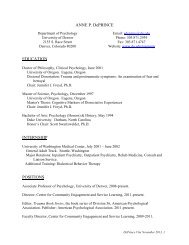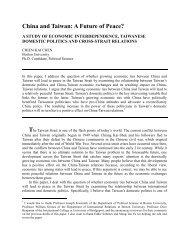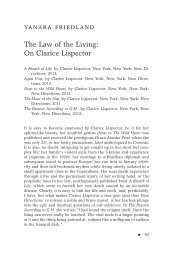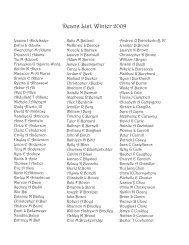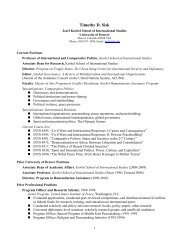Through a Speculum That Shines: Vision and Imagination in ...
Through a Speculum That Shines: Vision and Imagination in ...
Through a Speculum That Shines: Vision and Imagination in ...
Create successful ePaper yourself
Turn your PDF publications into a flip-book with our unique Google optimized e-Paper software.
History of Religions Feb 1997 v36 n3 p265(10) Page 2<br />
<strong>Through</strong> a <strong>Speculum</strong> <strong>That</strong> <strong>Sh<strong>in</strong>es</strong>: <strong>Vision</strong> <strong>and</strong> <strong>Imag<strong>in</strong>ation</strong> <strong>in</strong> Medieval<br />
Jewish Mysticism.<br />
<strong>and</strong> German-Jewish pietist Eleazar of Worms. The<br />
esoteric writ<strong>in</strong>gs of the latter <strong>and</strong> <strong>in</strong>deed of the whole<br />
pietistic circle of Ashkenaz are given much attention <strong>in</strong> this<br />
work, as <strong>in</strong> Wolfson’s oeuvre generally. The careful<br />
read<strong>in</strong>g of the Ashkenazic sources, most still <strong>in</strong><br />
manuscript, has been one of his major contributions to the<br />
field. Wolfson’s study follows up on Scholem’s later<br />
work(3) <strong>in</strong> cont<strong>in</strong>u<strong>in</strong>g to trace the <strong>in</strong>fluence of Ashkenazic<br />
esotericism on the earliest development of what may be<br />
properly considered Kabbalah, emerg<strong>in</strong>g <strong>in</strong> Provence <strong>and</strong><br />
Catalonia <strong>in</strong> the late twelfth century.<br />
But it is Wolfson’s underst<strong>and</strong><strong>in</strong>g of Kabbalah itself that is<br />
of greatest <strong>in</strong>terest here; the entire book works its way<br />
toward, <strong>and</strong> <strong>in</strong> many ways is shaped by, the two f<strong>in</strong>al <strong>and</strong><br />
most important chapters, those deal<strong>in</strong>g with early<br />
Kabbalah <strong>and</strong> the late thirteenth-century Zohar, the most<br />
important Kabbalistic work. Wolfson shows how Kabbalah,<br />
<strong>and</strong> particularly the Zohar, is heir to the entire earlier<br />
tradition, <strong>in</strong>tegrat<strong>in</strong>g Midrashic, merkovah, <strong>and</strong><br />
philosophical elements <strong>in</strong>to the develop<strong>in</strong>g Kabbalistic<br />
worldview.<br />
The most important creation of the Kabbalists lies <strong>in</strong> the<br />
realm of mystical symbolism <strong>and</strong> the dar<strong>in</strong>g<br />
re<strong>in</strong>corporation of myth <strong>in</strong>to Judaism. When look<strong>in</strong>g at the<br />
Zohar, one can easily ga<strong>in</strong> the impression that it is more<br />
the mythic than the mystical that lies at the heart of the<br />
enterprise. The essential myth of a God-head rent asunder<br />
<strong>and</strong> <strong>in</strong> search of reunion is told through a vast array of<br />
symbols. The structure of Kabbalah’s symbolism is a<br />
tenfold grid of associative clusters: each of the ten sefirot,<br />
ostensibly "aspects" of the div<strong>in</strong>e self or stages <strong>in</strong> the flow<br />
of God’s self-reveal<strong>in</strong>g emanation, is <strong>in</strong> function a group of<br />
terms <strong>and</strong> verbal pictures, each member of the cluster<br />
identified with all the others. While talk<strong>in</strong>g about the same<br />
sefirah or pair of sefirot <strong>in</strong> union, the author will with utmost<br />
grace let his symbolic imag<strong>in</strong>ation flow from water imagery<br />
to that of light, from sexual metaphors to those of one or<br />
another of the comm<strong>and</strong>ments, <strong>and</strong> then on to beasts <strong>and</strong><br />
birds or Jerusalem <strong>and</strong> the history of the Jews. With<strong>in</strong> a<br />
given cluster all the symbols, whether drawn from nature<br />
or from tradition, are supposed to bear the same valence.<br />
Thus is created a symbolically enriched language, a<br />
l<strong>in</strong>guistic entity given a new profundity by this network of<br />
associations across the bounds of nature, Torah text, <strong>and</strong><br />
Jewish religious tradition. The more mythic works of the<br />
Kabbalah, <strong>in</strong>clud<strong>in</strong>g the Bahir <strong>and</strong> the Zohar literature,<br />
richly describe the <strong>in</strong>ner life of the Godhead through the<br />
<strong>in</strong>terplay of these ten multiplicities of symbols. S<strong>in</strong>ce for<br />
the Kabbalist, as Wolfson notes so aptly, hermeneutics<br />
<strong>and</strong> experience are fully united, we may say that to speak<br />
sefirotic language is itself to enter the world of the sefirot<br />
<strong>and</strong> to live on that <strong>in</strong>tensified plane of be<strong>in</strong>g. It is <strong>in</strong> this<br />
way that the mythic <strong>and</strong> the mystical become one.<br />
For example, note the n<strong>in</strong>th sefirah that is much the<br />
subject of my discussion below. This locus with<strong>in</strong> the<br />
div<strong>in</strong>e realm is designated by such symbols as Righteous<br />
One, Foundation of the Cosmos, Phallus (of the sefirot <strong>in</strong><br />
<strong>and</strong>ropic form), Covenant, Bow, Spr<strong>in</strong>g (of water), Deer,<br />
All, Joseph, Sabbath Day, Artisan, End, Statute, Noah,<br />
<strong>and</strong> many more. Like many of the Kabbalistic symbolic<br />
configurations, this symbol-cluster is loaded with a deep<br />
<strong>in</strong>ner tension. It is the phallus of God when depicted <strong>in</strong><br />
manlike form. As such, it symbolizes maleness, potency,<br />
seed, the life force, the flow of div<strong>in</strong>e energy <strong>in</strong>to the world.<br />
But it is also designated as saddiq, the Righteous One,<br />
precisely <strong>in</strong>sofar as righteousness means control of the<br />
sexual passions, "guard<strong>in</strong>g the covenant," <strong>and</strong> chastity <strong>in</strong><br />
general. Joseph is the biblical <strong>in</strong>carnation of the n<strong>in</strong>th<br />
sefirah precisely because he resisted the wiles of<br />
Potiphar’s wife. The Kabbalist, himself seek<strong>in</strong>g to fulfill the<br />
human ideal of saddiq, identifies most directly with this<br />
aspect of the Godhead. Behaviorally, he emulates this<br />
aspect of div<strong>in</strong>ity by extremes of chastity, go<strong>in</strong>g quite<br />
beyond that required by Jewish law. But <strong>in</strong> his imag<strong>in</strong>ative<br />
life he experiences the deep <strong>in</strong>ner complexity of be<strong>in</strong>g<br />
God’s righteous disciple as well as His powerful (<strong>and</strong><br />
phallic) embodiment <strong>in</strong> the lower world; <strong>in</strong>nocence <strong>and</strong><br />
eros must be jo<strong>in</strong>ed <strong>in</strong> him.<br />
Another key figure <strong>in</strong> Kabbalistic symbolism is the crown of<br />
God; both the first ("highest") <strong>and</strong> tenth ("lowest") sefirot<br />
are designated as crowns, the former by the term keter<br />
<strong>and</strong> the latter as `atarah. The ultimate goal of Kabbalistic<br />
mysticism, as I hope to demonstrate elsewhere,(4) is the<br />
reunion of these two crowns, an event <strong>in</strong> which sheth<strong>in</strong>ah,<br />
the tenth sefirah <strong>and</strong> div<strong>in</strong>e consort, but also <strong>in</strong>clud<strong>in</strong>g the<br />
historical people Israel <strong>and</strong> the mystic’s own soul,(5) is<br />
reabsorbed <strong>in</strong>to the oneness of the reconstituted s<strong>in</strong>gle<br />
crown. To effect this union, shekh<strong>in</strong>ah undertakes a long<br />
journey through the symbolic realms. Her primary goal is<br />
the arousal of her cosmic spouse, the blessed Holy One or<br />
the God of rabb<strong>in</strong>ic Judaism, identified either with tif’eret,<br />
the sixth sefirah, or with the six <strong>in</strong>termediate sefirot (fourth<br />
through n<strong>in</strong>th) <strong>in</strong> toto. <strong>That</strong> mascul<strong>in</strong>e God figure, to whom<br />
she was once jo<strong>in</strong>ed as a Siamese tw<strong>in</strong> (they had to be<br />
separated <strong>in</strong> the course of the creation process), now<br />
faces her from above <strong>and</strong> is thus closest to her <strong>in</strong> his lower<br />
appendage, "covenant" or the circumcised phallus of the<br />
male deity. S<strong>in</strong>ce the word ’atarah can refer to the corona<br />
of the penis as well as to a crown upon the head,<br />
Kabbalists made the dar<strong>in</strong>g claim that the first step <strong>in</strong><br />
shekh<strong>in</strong>ah’s ascent was her attachment to this n<strong>in</strong>th<br />
sefirah as its corona. This union, that which Wolfson<br />
describes as the <strong>and</strong>rogynous phallus, is the first step<br />
toward the reunion of sheth<strong>in</strong>ah with tif’eret. This<br />
- Repr<strong>in</strong>ted with permission. Additional copy<strong>in</strong>g is prohibited. - G A L E G R O U P<br />
Information Integrity



